The Bolometer Market is estimated to be valued at USD 2.8 billion in 2025 and is projected to reach USD 5.3 billion by 2035, registering a compound annual growth rate (CAGR) of 6.5% over the forecast period.
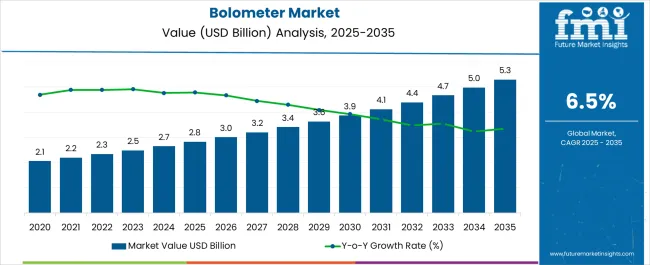
| Metric | Value |
|---|---|
| Bolometer Market Estimated Value in (2025 E) | USD 2.8 billion |
| Bolometer Market Forecast Value in (2035 F) | USD 5.3 billion |
| Forecast CAGR (2025 to 2035) | 6.5% |
The Bolometer market is witnessing steady growth driven by rising demand for highly sensitive thermal detection systems across multiple industries. The market growth is being supported by advancements in material science, particularly in semiconductor technologies, which have improved sensitivity, response time, and accuracy of bolometer devices. Increasing applications in automotive, aerospace, and astronomical research are further expanding adoption, as these industries require precise temperature measurements and infrared detection capabilities.
Investment in research and development of low-noise, high-resolution thermal imaging systems has enhanced the capabilities of bolometers, enabling their integration into modern sensing systems. The market outlook is further strengthened by the need for efficient environmental monitoring, industrial process control, and safety applications, where accurate thermal sensing is critical.
The growing emphasis on intelligent vehicle safety systems, such as pedestrian detection and autonomous driving technologies, also contributes to bolometer deployment Overall, as technological innovations continue and demand for high-precision thermal detection increases, the Bolometer market is expected to sustain consistent growth globally.
The bolometer market is segmented by type, application, end use industry, and geographic regions. By type, bolometer market is divided into Semiconductor Bolometer, Superconducting Bolometer, and Hot Electron Bolometer. In terms of application, bolometer market is classified into Astronomical Applications, Detection Of Forest Fire, Air Surveillance, In Fingerprint Scanners, Detection Of Concealed Weapons, In Particle Detectors, and In Thermal Cameras. Based on end use industry, bolometer market is segmented into Automotive, Aerospace, Defence And Security, and Others (Scientific Research). Regionally, the bolometer industry is classified into North America, Latin America, Western Europe, Eastern Europe, Balkan & Baltic Countries, Russia & Belarus, Central Asia, East Asia, South Asia & Pacific, and the Middle East & Africa.
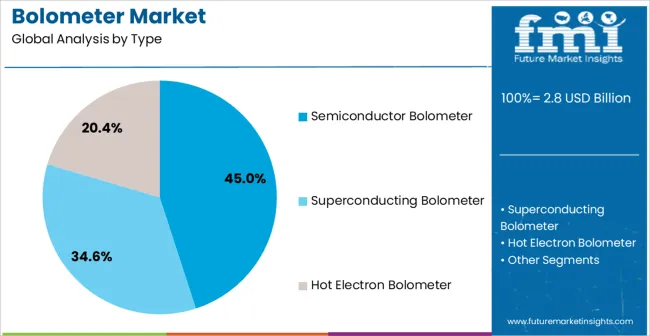
The Semiconductor Bolometer segment is projected to hold 45.00% of the Bolometer market revenue in 2025, making it the leading type in the industry. This dominance is attributed to the high sensitivity, stability, and fast response offered by semiconductor materials, which allow precise measurement of incident infrared radiation. Semiconductor bolometers are widely adopted in applications requiring reliable performance under varying environmental conditions, including industrial monitoring, automotive safety systems, and scientific research.
Growth has been fueled by the ability to integrate semiconductor bolometers into compact, modular devices while maintaining high accuracy and low noise performance. Their compatibility with modern electronic systems and ease of scalability for large sensor arrays have further reinforced their market position.
Additionally, the low power consumption and long-term durability of semiconductor bolometers have made them a preferred choice among system designers seeking both performance and cost-effectiveness Future growth is expected to continue as semiconductor-based designs evolve to meet higher resolution and faster response requirements for advanced applications.
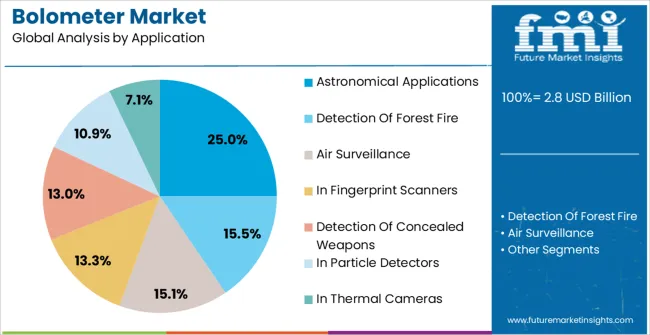
The Astronomical Applications segment is expected to account for 25.00% of the Bolometer market revenue in 2025, reflecting its leading role in scientific and research use cases. The high sensitivity and accuracy of bolometers make them essential in detecting faint cosmic radiation and thermal signals in space observatories and telescopes. Growth in this segment has been driven by increased investment in space research programs, the development of next-generation telescopes, and international collaboration on deep-space missions.
Bolometers are particularly favored for infrared astronomy, where precision thermal detection is critical for analyzing celestial bodies and cosmic phenomena. The adoption of advanced semiconductor bolometers within this application has improved signal-to-noise ratios and enabled more detailed data collection.
Furthermore, the push for miniaturized, lightweight, and highly sensitive thermal sensors for satellite payloads has enhanced the role of bolometers in astronomical research Continuous advancements in material technology and cooling systems are expected to expand the utility of bolometers in space exploration and observational astronomy.
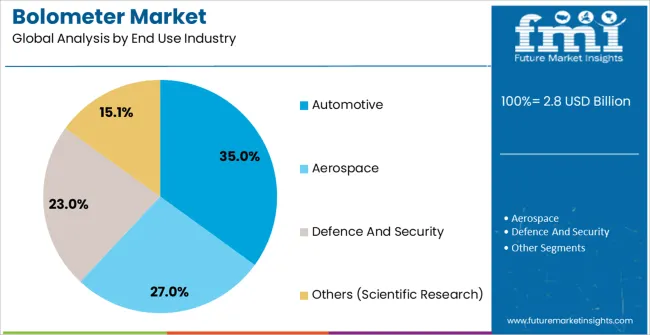
The Automotive end-use industry segment is projected to hold 35.00% of the Bolometer market revenue in 2025, establishing it as the largest end-use sector. The growth of this segment has been primarily driven by the increasing integration of thermal imaging systems in vehicles for pedestrian detection, driver assistance, and autonomous navigation technologies. Bolometers are being deployed to provide enhanced safety features by detecting heat signatures in low visibility conditions such as fog, rain, or nighttime driving.
The adoption has been accelerated by rising regulations and safety standards in automotive design, which emphasize the need for advanced sensing technologies to prevent accidents. Semiconductor bolometers, with their high sensitivity and reliability, are particularly suited for these automotive applications due to their compact form factor and compatibility with in-vehicle electronic systems.
Additionally, growing demand for intelligent and autonomous vehicles has reinforced the adoption of thermal detection solutions Continuous improvements in sensor resolution, response speed, and integration capabilities are expected to further strengthen the automotive sector’s contribution to bolometer market growth.
A bolometer is an instrument used to measure heat or infrared radiation. It is basically a highly sensitive thermometer. Bolometer can be utilized in combination of spectroscopy to gather information related to structures of certain chemical compounds.
A bolometer consists of an absorptive component made up of a thin metal layer (such as a strip of blackened platinum metal). The absorptive element is connected to a thermal reservoir through a thermal linkage. When radiation comes in contact with the absorptive strip, its temperature rises above the reservoir’s temperature due to the absorption of radiation by the absorptive element. i.e radiation falling on the strip changes its resistance to initiate an electric current. This change of resistance is logged by a sensitive electric meter.
Some of the benefits of bolometer include; it can measure non-ionizing particles in addition to ionizing particles and photons. It is extremely efficient in terms of sensitivity and energy resolution when compared to other conventional particle detectors.
It operates at room temperature and hence does not require cooling. The applications of bolometer include astronomical applications, detection of the forest fire, Air surveillance, in fingerprint scanners, detection of concealed weapons, in particle detectors and in thermal cameras.
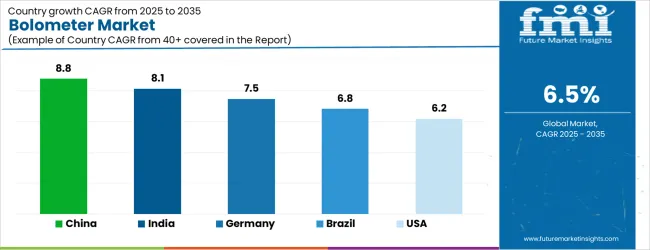
| Country | CAGR |
|---|---|
| China | 8.8% |
| India | 8.1% |
| Germany | 7.5% |
| Brazil | 6.8% |
| USA | 6.2% |
| UK | 5.5% |
| Japan | 4.9% |
The Bolometer Market is expected to register a CAGR of 6.5% during the forecast period, exhibiting varied country level momentum. China leads with the highest CAGR of 8.8%, followed by India at 8.1%. Developed markets such as Germany, France, and the UK continue to expand steadily, while the USA is likely to grow at consistent rates. Japan posts the lowest CAGR at 4.9%, yet still underscores a broadly positive trajectory for the global Bolometer Market. In 2024, Germany held a dominant revenue in the Western Europe market and is expected to grow with a CAGR of 7.5%. The USA Bolometer Market is estimated to be valued at USD 992.9 million in 2025 and is anticipated to reach a valuation of USD 992.9 million by 2035. Sales are projected to rise at a CAGR of 0.0% over the forecast period between 2025 and 2035. While Japan and South Korea markets are estimated to be valued at USD 140.6 million and USD 92.0 million respectively in 2025.
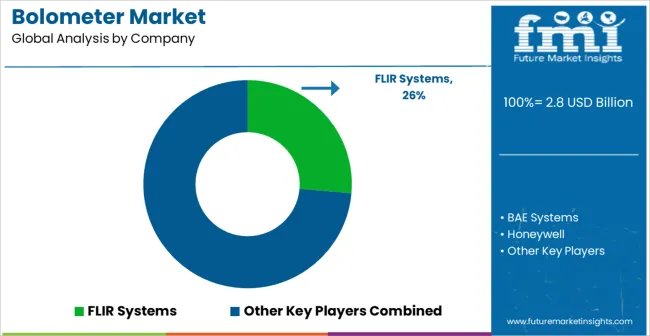
| Item | Value |
|---|---|
| Quantitative Units | USD 2.8 Billion |
| Type | Semiconductor Bolometer, Superconducting Bolometer, and Hot Electron Bolometer |
| Application | Astronomical Applications, Detection Of Forest Fire, Air Surveillance, In Fingerprint Scanners, Detection Of Concealed Weapons, In Particle Detectors, and In Thermal Cameras |
| End Use Industry | Automotive, Aerospace, Defence And Security, and Others (Scientific Research) |
| Regions Covered | North America, Europe, Asia-Pacific, Latin America, Middle East & Africa |
| Country Covered | United States, Canada, Germany, France, United Kingdom, China, Japan, India, Brazil, South Africa |
| Key Companies Profiled | FLIR Systems, BAE Systems, Honeywell, L-3 Communications, Mikrosens, Teledyne DALSA, Infrared Laboratories, Testo, Raytheon, GE, and Hamamatsu |
The global bolometer market is estimated to be valued at USD 2.8 billion in 2025.
The market size for the bolometer market is projected to reach USD 5.3 billion by 2035.
The bolometer market is expected to grow at a 6.5% CAGR between 2025 and 2035.
The key product types in bolometer market are semiconductor bolometer, superconducting bolometer and hot electron bolometer.
In terms of application, astronomical applications segment to command 25.0% share in the bolometer market in 2025.






Our Research Products

The "Full Research Suite" delivers actionable market intel, deep dives on markets or technologies, so clients act faster, cut risk, and unlock growth.

The Leaderboard benchmarks and ranks top vendors, classifying them as Established Leaders, Leading Challengers, or Disruptors & Challengers.

Locates where complements amplify value and substitutes erode it, forecasting net impact by horizon

We deliver granular, decision-grade intel: market sizing, 5-year forecasts, pricing, adoption, usage, revenue, and operational KPIs—plus competitor tracking, regulation, and value chains—across 60 countries broadly.

Spot the shifts before they hit your P&L. We track inflection points, adoption curves, pricing moves, and ecosystem plays to show where demand is heading, why it is changing, and what to do next across high-growth markets and disruptive tech

Real-time reads of user behavior. We track shifting priorities, perceptions of today’s and next-gen services, and provider experience, then pace how fast tech moves from trial to adoption, blending buyer, consumer, and channel inputs with social signals (#WhySwitch, #UX).

Partner with our analyst team to build a custom report designed around your business priorities. From analysing market trends to assessing competitors or crafting bespoke datasets, we tailor insights to your needs.
Supplier Intelligence
Discovery & Profiling
Capacity & Footprint
Performance & Risk
Compliance & Governance
Commercial Readiness
Who Supplies Whom
Scorecards & Shortlists
Playbooks & Docs
Category Intelligence
Definition & Scope
Demand & Use Cases
Cost Drivers
Market Structure
Supply Chain Map
Trade & Policy
Operating Norms
Deliverables
Buyer Intelligence
Account Basics
Spend & Scope
Procurement Model
Vendor Requirements
Terms & Policies
Entry Strategy
Pain Points & Triggers
Outputs
Pricing Analysis
Benchmarks
Trends
Should-Cost
Indexation
Landed Cost
Commercial Terms
Deliverables
Brand Analysis
Positioning & Value Prop
Share & Presence
Customer Evidence
Go-to-Market
Digital & Reputation
Compliance & Trust
KPIs & Gaps
Outputs
Full Research Suite comprises of:
Market outlook & trends analysis
Interviews & case studies
Strategic recommendations
Vendor profiles & capabilities analysis
5-year forecasts
8 regions and 60+ country-level data splits
Market segment data splits
12 months of continuous data updates
DELIVERED AS:
PDF EXCEL ONLINE

Thank you!
You will receive an email from our Business Development Manager. Please be sure to check your SPAM/JUNK folder too.
Chat With
MaRIA